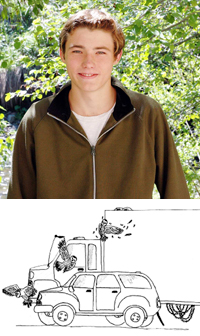A valley student has received nationwide recognition from the American Museum of Natural History in New York City.
Community School ninth-grader Jon Atkinson won his division of the museum's Young Naturalist Awards for an 18-page paper, "Barn Owls on the Side of the Road." Atkinson is one of two ninth-graders in the nation to win this award and one of 12 students in the United States to do so.
Community School science teacher Harry Weekes lauded Atkinson's potential.
"This kid is my 'once in a career' kid in terms of his skills in biology and natural history," Weekes said in an e-mail. "He is a Rachel Carson, John Muir, Aldo Leopold kind of guy all rolled into one."
As part of his prize, Atkinson and his family will be headed to New York City for an awards ceremony June 22, and a behind-the-scenes tour of the museum. His paper will also be excerpted in Natural History magazine at an undetermined point in the future.
"I have always liked nature and always enjoyed being outside," Atkinson said. "It's really interesting to be able to connect things in nature."
The connections Atkinson made presented a compelling argument for how and why barn owls around the city of Hagerman are turning up dead along highways in alarming numbers. His project to study why so many owls had been hit by traffic began one January evening while traveling a 29-mile stretch of highway with his parents, Chip and Monica Atkinson, between Hagerman and Jerome.
"I started to notice many dead barn owls lying in the area around the highway," Atkinson wrote in his paper. "I was amazed by how many I counted and was surprised that I had not noticed the quantity of dead birds before."
Atkinson began his study with meticulous effort and attention to detail. He began to count the dead barn owls he spotted on the side of the road while his dad called out mile markers. He also defined each mile with a description of the surrounding environment—granary, cornfield, dairy, town, exit, overpass, underpass and trees.
What Atkinson found was a strong correlation between dead barn owls and their proximity to granaries, dairies and towns.
Atkinson's conclusion pointed to several factors. First, in the winter, food can be scarce. That coupled with the return of great horned owls puts pressure on barn owls in their search for food. In addition, areas close to granaries and dairies with trees or overpasses nearby saw the highest number of bead barn owls.
"This gives the owls a perfect roosting place," Atkinson said. "They are pretty awkward fliers and appear to prefer to glide down on their prey from an elevated position."
The connection between granaries and dairies is the consistent supply of grain on location, which attracts mice that are in turn eaten by barn owls. During summer months, fields are planted and mice are better distributed through the area. During the winter, the owls' main food source concentrates close to highways where cows are fed. The owls get hit by traffic as they glide across the road to hunt mice.
"My results seem to point to the fact there are more dead barn owls near dairies and granaries," Atkinson said. "There are also many dead owls near towns. Barn owls co-exist with man. We can not move towns but maybe we should not feed cows fifteen feet from the highway.
"In nature, everything is related. Solutions to problems might be in places that we do not expect like studying the mice in order to save the owls."






































